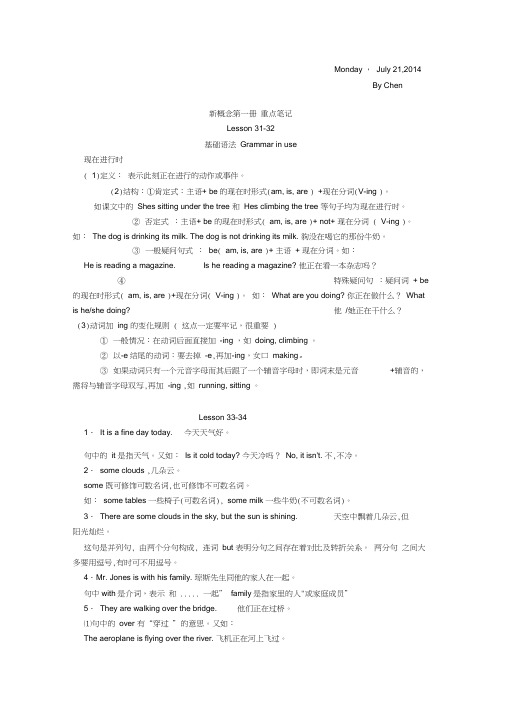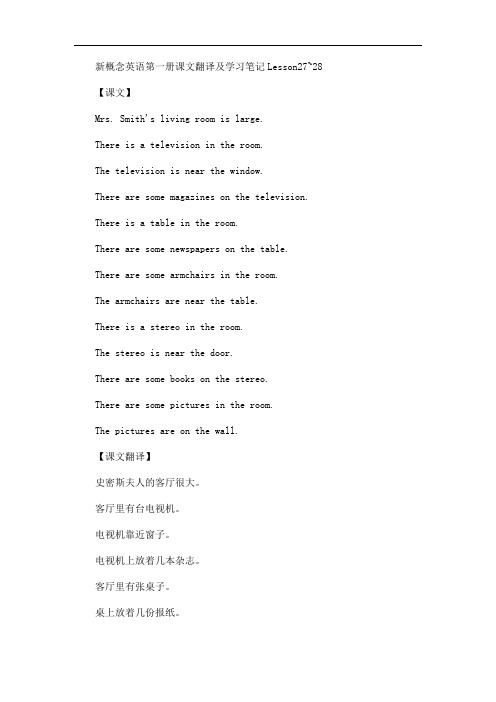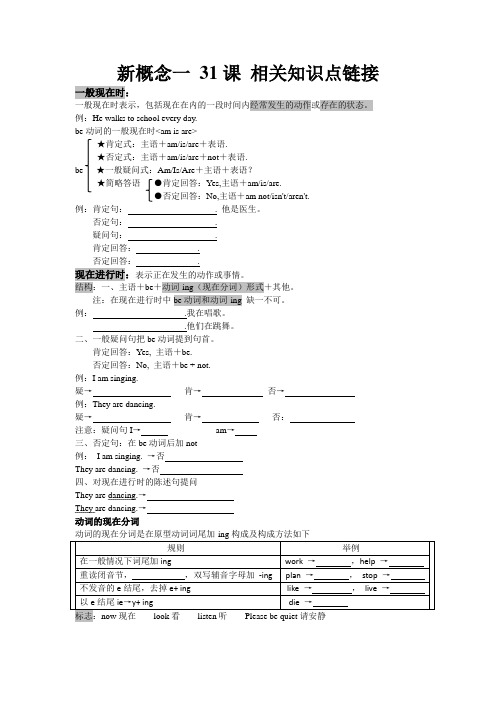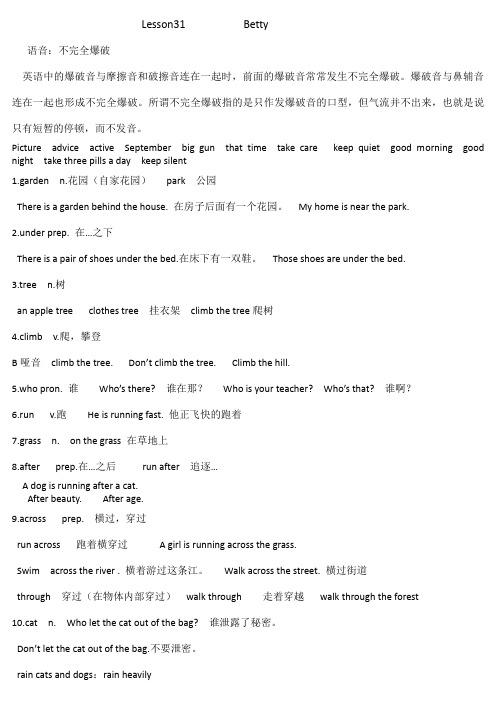新概念英语第一册第31课听课笔记
裕兴新概念英语笔记:Lesson 31 Where's sally

Lesson 31 Where's sally?语音 -- 不完全爆破:英语中的爆破音与摩擦音和破擦音连在一起时,前面的爆破音常常不发生不完全爆破。
爆破音与鼻辅音连在一起也形成不完全爆破。
所谓不完全爆破指的是只作发爆破音的口形,但气流并不出来,也就是说只有短暂的停顿,而不发音。
pictureadviceactiveSeptemberbig gunthat timetake carekeep quietgood morninggood nighttake three pills a daykeep silentNew words and expressions:garden n. 花园under prep.在……之下tree n.树climb v.爬,攀登who pron.谁run v.跑grass n. 草,草地after prep.在……之后across prep. 横过,穿过cat n.猫garden n. 花园(自家花园)park n.公园(公共地方)eg. There is a garden behind the house.在房子的后面有一个花园。
eg. My home is near the park.我家靠近公园。
under prep.在…………之下eg. There is a pair of shoes under the bed.在床的下面有一双鞋。
eg. Those shoes are under the bed.tree n.树an apple tree 一棵苹果树clothes tree 挂衣架climb the tree 爬树climb v. 爬,攀登b 哑音climb the treeeg. Don't climb the tree. 不要爬树。
climb the hill.who pron.谁(引导疑问句)eg. Who's there? 谁在那?eg. Who is your teacher? 谁是你的教师。
新概念英语第一册31-32课(第二课时)

现在进行时: 否定句结构: 主语+ am/is/are not + 动词ing +其他
I am not eating. You/ We/ They are not eating. He/ She/ It is not eating.
现在进行时的否定句就是
在be动词后面加not。
①她现在没看报纸。 She is not reading a newspaper. ②他的弟弟没在扫地。 His brother is not sweeping the floor. ③他们没在看电视。 They are not watching TV. ④我没在穿外套。 I am not putting on my coat. ⑤我们没在看一只猫。 We are not looking at the cat.
glass
basket 篮子 /ba:skit/
篮球 basket balle is YaoMing.
He is hoopman.
who pron.谁
Who is there? 谁在那? Who is your teacher? 谁是你的老师? Who is that? 谁来了?/谁的电话?
现在进行时: 一般疑问句结构:
Is/Are + 主语 + 动词ing +其他
Are you we/ they eating ? Is he/ she/ it eating?
一般疑问句和回答
问句, 直接把be提前,
Are you drawing ?
Is he standing?
肯定回答: Yes, 主语+be. 否定回答: No, 主语+be+not. Yes, I am./ No, I’m not. Yes,he is. / No, he isn’t.
新概念第一册31课Lesson31

• I beg your pardon? • Who’s climbing the tree? • Tim is. • 琼:你说什么?谁在爬树? • 杰克:蒂姆在爬树。
• I beg your pardon?=Pardon?你说什么? • who用来提问谁(问人称) • Tim is.是Tim is climbing the tree.的缩写
动词现在分词的变化规则: 1. 一般情况下,直接在动词后加ing work ---- working do ----- doing 2. 以不发音的e结尾,去e加ing take ----- taking make ----- making dance ----- dancing
3双.以写重词读尾闭辅音音节字结母H尾,o的再m动加词ein(gw。辅o元rk辅),
TEXT 课文
• JEAN: Where's Sally, Jack? • JACK: She's in the garden, Jean.
• 琼:杰克,萨莉在哪儿? 杰克:她在花园里,琼。
• Where’s= Where is 询问地点,在哪里 • She’s=She is • in the garden 在花园
grammar语法 现在进行时
• 现在进行时表示此时此刻正在进行或发生的动作
• 现在进行时的结构: • 肯定句:主语 + be(am/is/are) + doing (动词ing) • 否定句:主语 + be + not + doing • 一般疑问句:be + 主语 + doing • 回答:Yes, 主 + be. / No, 主 + be + not.
新概念第一册Lesson31-40重点笔记

Monday ,July 21,2014By Chen新概念第一册重点笔记Lesson 31-32基础语法Grammar in use现在进行时( 1)定义:表示此刻正在进行的动作或事件。
(2)结构:①肯定式:主语+ be的现在时形式(am, is, are ) +现在分词(V-ing )。
如课文中的Shes sitting under the tree 和Hes climbing the tree 等句子均为现在进行时。
②否定式:主语+ be 的现在时形式( am, is, are )+ not+ 现在分词 ( V-ing )。
如:The dog is drinking its milk. The dog is not drinking its milk. 豿没在喝它的那份牛奶。
③一般疑问句式:be( am, is, are )+ 主语+ 现在分词。
如:He is reading a magazine. Is he reading a magazine? 他正在看一本杂志吗?④特殊疑问句:疑问词+ be 的现在时形式( am, is, are )+现在分词( V-ing )。
如:What are you doing? 你正在做什么?What is he/she doing? 他/她正在干什么?(3)动词加ing 的变化规则 ( 这点一定要牢记,很重要 )①一般情况:在动词后面直接加-ing ,如doing, climbing 。
②以-e结尾的动词:要去掉-e,再加-ing,女口making。
③如果动词只有一个元音字母而其后跟了一个辅音字母时,即词末是元音+辅音的,需将与辅音字母双写,再加-ing ,如running, sitting 。
Lesson 33-341.It is a fine day today. 今天天气好。
句中的it 是指天气。
又如:Is it cold today? 今天冷吗?No, it isn't. 不,不冷。
新概念英语第一册第31课

新概念英语第一册第31课Lesson 31: Success Story.In today's fast-paced world, success is often equated with wealth, fame, and status. However, the true meaning of success lies beyond these superficial markers. Success is a journey that involves perseverance, hard work, and continuous learning. Lesson 31 of New Concept English Book 1 beautifully illustrates this concept through an engaging narrative.The lesson begins with a man named John who dreams of becoming a writer. John is not wealthy, famous, or highly educated. He is an ordinary man with a passion for writing. However, this passion drives him to pursue his dream with determination and focus.John's journey to success is not easy. He faces rejection and disappointment, but he never gives up. He perseveres, learning from his mistakes and refining hiscraft. His hard work eventually pays off when he receiveshis first acceptance letter for a short story. This milestone encourages him to keep going, and his writing career slowly begins to take off.The lesson teaches us that success is not solely determined by external factors like wealth or fame. True success comes from following our passions, persevering in the face of challenges, and continuously improving ourselves. John's story is an inspiration to all of us who strive for success in our own lives.Moreover, success is not a destination; it is a journey. John's story reminds us that the road to success is often filled with obstacles and setbacks. However, it is these challenges that help us grow and learn. Each failure brings us closer to our goals, and each success is a steppingstone to even greater achievements.In conclusion, Lesson 31 of New Concept English Book 1is a powerful reminder of the true meaning of success. It teaches us that success is not about material possessionsor external validation; it is about following our passions, persevering through challenges, and continuously improving ourselves. John's story encourages us to believe in ourselves and to never give up on our dreams. As we embark on our own journeys of success, let us remember the lessons learned from John's story and apply them to our lives.。
新概念课堂笔记 第一册 Lesson 31-32

新概念英语课堂笔记第一册Lesson 31-32garden【用法】n. 花园,庭院【扩展】gardener园丁gardening园艺【词组】vegetable garden菜园子under【用法】prep. 在……之下,在……正下方【辨析】over <反> under:指在物体的正上方或正下方,外表不接触;above <反> below:指在物体的上方或下方,外表不接触;on <反> beneath:指在物体的外表上或下,外表接触。
【扩展】underground adj. 地下的underwear n. 内衣tree【用法】n. 树【辨析】in the tree在树上,表示把物体放在树上或物体停留在树上。
on the tree在树上,表示长在树上,比方树叶,果子等。
climb【用法】v. 爬,攀登【词组】go climbing去爬山climb the mountain爬山climb down爬下来climb up爬上去【扩展】climber爬山者,爬山运发动who【用法】pron. 谁〔疑问代词〕引导特殊疑问句。
who的宾格形式为:whom〔谁〕;所有格形式为:whose〔谁的〕【例句】Who is that girl?那个女孩是谁?run【用法】v. 跑;经营,管理【词组】run after追逐,追赶run away逃走run away with sb. 带人私奔run away with sth. 携物潜逃run out of从……跑出来run into跑进……里run a hotel/a school管理旅馆,学校after【用法】prep. 在……之后【词组】day after day日复一日after that下一步,然后【反义】before 在……之前【辨析】after和behind〔在……后面〕after指时间的先后及顺序的先后behind指位置的前后【例句】After you, please. 你先请I will do my homework after dinner.晚饭后我要做作业。
新概念英语第一册自学笔记

4 She can type very well, but he can't.
5 They are working hard, but we aren't.
6 He is reading a magazine, but I am not.
B
1 Where does she come from?
Does she come fromEngland?
No, she doesn't come fromEngland. She comes from the U. S.
What nationality is she?
She's American.
B
1 Yes, he does.
He likes cabbage, but he doesn't want any.
2 Yes, he does.
He likes lettuce, but he doesn't want any.
3 Yes, I do.
I like peas, but I don't want any.
Does he come fromFrance?
No, he doesn't come fromFrance. He comes fromGermany.
What nationality is he?
He's German.
4 Where does he come from?
Does he come fromItaly?
词汇学习 Word study
新概念英语第一册课文翻译及学习笔记Lesson27~32(最新)

新概念英语第一册课文翻译及学习笔记Lesson27~28 【课文】Mrs. Smith's living room is large.There is a television in the room.The television is near the window.There are some magazines on the television. There is a table in the room.There are some newspapers on the table.There are some armchairs in the room.The armchairs are near the table.There is a stereo in the room.The stereo is near the door.There are some books on the stereo.There are some pictures in the room.The pictures are on the wall.【课文翻译】史密斯夫人的客厅很大。
客厅里有台电视机。
电视机靠近窗子。
电视机上放着几本杂志。
客厅里有张桌子。
桌上放着几份报纸。
客厅里有几把扶手椅。
这些扶手椅靠近桌子。
客厅里有台立体声音响。
音响靠近门。
音响上面有几本书。
客厅里有几幅画。
画挂在墙上。
【生词】living room 客厅near prep.靠近window n. 窗户armchair n. 扶手椅door n. 门picture n. 图画wall n. 墙【知识点讲解】1. 今天我们要继续学习和方位有关的表达方式。
文中提到:near sth. 靠近某物;on the wall,在墙上。
注意这里的介词用的是on,如果是in the wall 的话,那么意思就是“镶在墙里面”。
on和in这两个介词的意思,前者是在……之上,后者是在……里面,一般没有什么异议。
新概念一 31课 知识点

新概念一31课相关知识点链接一般现在时:一般现在时表示,包括现在在内的一段时间内经常发生的动作或存在的状态。
例:He walks to school every day.be动词的一般现在时<am is are>★肯定式:主语+am/is/are+表语.★否定式:主语+am/is/are+not+表语.be ★一般疑问式:Am/Is/Are+主语+表语?★简略答语●肯定回答:Yes,主语+am/is/are.●否定回答:No,主语+am not/isn't/aren't.例:肯定句:. 他是医生。
否定句:.疑问句:.肯定回答:.否定回答:.现在进行时:表示正在发生的动作或事情。
结构:一、主语+be+动词-ing(现在分词)形式+其他。
注:在现在进行时中be动词和动词-ing 缺一不可。
例:.我在唱歌。
.他们在跳舞。
二、一般疑问句把be动词提到句首。
肯定回答:Yes, 主语+be.否定回答:No, 主语+be + not.例:I am singing.疑→肯→否→例:They are dancing.疑→肯→否:注意:疑问句I→am→三、否定句:在be动词后加not例:I am singing. →否They are dancing. →否四、对现在进行时的陈述句提问They are dancing.→They are dancing.→动词的现在分词一.写出下列动词的ing形式1 run<跑> →2 smile<微笑> →3 play<玩> →4 write<写> →5 take<拿走> →6 ride<骑> →7 cut<切割> →8 put<放放置> →9 rain<下雨> →10 lie<说谎> →11 die<死> →12 stand<站> →二.单项选择()1. The dog is across the grass.A. runB. running c. to run D. runs()2. The boy is across the river.A. swimB. swimsC. swimmingD. swam()3.-What are your brothers doing now?-My brothers in the garden.A. playB. is play c. is playing D. are playing()4. Mr. Smith and his wife are the boats on the river: A. looking at B. look at C. look D. looking ()5.What the children ?-They are sleeping.A. are; doingB. is; doingC. do; doD. are; do三.用所给动词的正确形式填空1. The boys are (swim)in the river.2. The children are (run)out of the school.3. The girls are (put)on their coats.4. The teacher is (read)her books.5. She is (type)some letters.6. Sally is (come)out of the shop.7. The sun is (shine).8. They are (look)at the photos.9. The cats are (climb)the tree.10. Emma is (cook)a meal.。
最新新概念英语第一册Lesson31~36自学笔记精讲解析

最新新概念英语第一册Lesson31~36自学笔记精讲解析新概念英语第一册Lesson31~32自学笔记精讲解析1.climb v.(1)攀登,攀爬:The children are always climbing trees.孩子们总是在爬树。
He likes climbing mountains.他喜欢爬山。
(2)逐步上升(增长):The temperature is climbing steadily.温度正在慢慢地平稳上升。
The price of gold climbed back.金价逐渐回升了。
(3)(在社会地位等方面)往上爬:He is trying hard to climb to the top of the social ladder. 他正努力爬到社会的最顶层。
He has climbed to a very high position in his field.他已在自己的领域中爬到了一个很高的位置。
2.run v.(1)跑,奔跑:He is running quickly.他正飞快地跑着。
He runs a mile every morning to keep fit.他每天早晨跑一英里步以保持身体健康。
(2)流动;流出:The current is running strong.水流湍急。
Her eyes ran with tears.她落泪了。
(3)追赶;追逐:The dog is running after a cat.那只狗正在追赶一只猫。
Many young men are running after that girl.许多年轻人在追求那个姑娘。
语法 Grammar in use现在进行时(1)(1)在英文中若想表达此刻正在进行的动作或事件,要用动词的现在进行时形式。
现在进行时由be的现在时形式(am, is, are)+现在分词组成。
如课文中的She's sitting under the tree. 和He's climbing the tree. 等句子均为现在进行时。
新概念第一册31课笔记

Lesson31 Betty语音:不完全爆破英语中的爆破音与摩擦音和破擦音连在一起时,前面的爆破音常常发生不完全爆破。
爆破音与鼻辅音连在一起也形成不完全爆破。
所谓不完全爆破指的是只作发爆破音的口型,但气流并不出来,也就是说只有短暂的停顿,而不发音。
Picture advice active September big gun that time take care keep quiet good morning good night take three pills a day keep silent1.garden n.花园(自家花园)park 公园There is a garden behind the house. 在房子后面有一个花园。
My home is near the park.2.under prep. 在…之下There is a pair of shoes under the bed.在床下有一双鞋。
Those shoes are under the bed.3.tree n.树an apple tree clothes tree 挂衣架climb the tree爬树4.climb v.爬,攀登B哑音climb the tree. Don’t climb the tree. Climb the hill.5.who pron. 谁Who’s there? 谁在那?Who is your teacher? Who’s that? 谁啊?6.run v.跑He is running fast. 他正飞快的跑着7.grass n. on the grass 在草地上8.after prep.在…之后run after 追逐…A dog is running after a cat.After beauty. After age.9.across prep. 横过,穿过run across 跑着横穿过 A girl is running across the grass.Swim across the river . 横着游过这条江。
(完整版)新概念英语第一册课文翻译及学习笔记Lesson31

新概念英语第一册课文翻译及学习笔记Lesson31【课文】JEAN: Where's Sally, Jack?JACK: She's in the garden, Jean.JEAN: What's she doing?JACK: She's sitting under the tree.JEAN: Is Tim in the garden, too?JACK: Yes, he is.He's climbing the tree.JEAN: I beg your pardon?Who's climbing the tree?JACK: Tim is.JEAN: What about the dog?JACK: The dog's in the garden, too.It's running across the grass.It's running after a cat.【课文翻译】琼:杰克,萨莉在哪儿?杰克:她在花园里,琼。
琼:她在干什么?杰克:她正在树荫下坐着。
琼:蒂姆也在花园里吗?杰克:是的,他也在花园里。
他正在爬树。
琼:你说什么?谁在爬树?杰克:蒂姆在爬树。
琼:那么狗呢?杰克:狗也在花园里。
它正在草地上跑,在追一只猫。
【生词】garden n. 花园under prep.在……这下tree n. 树climb v. 爬,攀登who pron.谁run v. 跑grass n. 草,草地after prep.在……之后across prep.横过,穿过cat n. 猫【知识点讲解】1. 今天要学习一个重要的语法点:现在实行时态。
在英语中,要表达正在发生的动作或事件,需要用这个时态。
这个时态的基本格式是:be动词现在时+动词的现在实行时态简单一点说就是"am/are/is + 动词ing形式"。
比如课文中的"She's sitting..." "He's climbing..." "It's running..."动词变成现在实行时态基本格式就是在后面直接加ing,比如climb-climbing, walk-walking, catch-catching...如果动词以e结尾,则去掉e加ing,比如give-giving, move-moving...如果动词只有一个元音字母,并在其后跟一个辅音字母,则将辅音字母双写、再加ing。
- 1、下载文档前请自行甄别文档内容的完整性,平台不提供额外的编辑、内容补充、找答案等附加服务。
- 2、"仅部分预览"的文档,不可在线预览部分如存在完整性等问题,可反馈申请退款(可完整预览的文档不适用该条件!)。
- 3、如文档侵犯您的权益,请联系客服反馈,我们会尽快为您处理(人工客服工作时间:9:00-18:30)。
新概念英语第一册听课笔记-第31课
Lesson 31 Where’s Sally?
garden n. 花园
under prep. 在……之下
tree n. 树
climb v. 爬,攀登
who pron. 谁
run v. 跑
grass n. 草,草地
after prep. 在……之后
across prep. 横过,穿过
cat n. 猫
garden centre:花卉中心
garden city:花园城市
savage garden:野人花园
in the garden:在花园里
under the tree:在树下
family tree:家谱
tree ring:年轮
climb the tree:爬树
run across the grass:跑过草地
run after:在……之后跑
语法――时态:
在第一册出现了八种时态
1.首先了解概念
2.时态――动词变化规则,时间的状态
now -- 现在进行时
usually, often, always... -- 一般现在时
already, yet -- 现在进行时
现在进行时,表示现在正在进行或者发生的动作、状态;
表示现阶段正在进行或发生,但说话的此刻动作不一定进行;
后面加一个将来的时间,可以表示打算做的事情。
结构:S. + be + V.-ing
S. + be + not + V.-ing
Be + S. +v.-ing?
Y es, S. + be / No, S. + be + not
What + be + S. + v.-ing
What is Sally doing? / Tim doing? / What are they doing? Are they climbing the tree?
Is she sitting under the tree?
The dog is / isn’t running after the cat.
Is the dog running after the cat?
Y es, it is. / No, it isn’t.
I am speaking / talking.
Sam is climbing the tree.
We are listening.
I am studying English in New Oriental School.
I am reading Gone with the wind.
★Text
Where’s Sally, Jack?
She’s in the garden, Jane.
What’s she doing?
She’s sitting under the tree.
Is Tim in the garden, too?
Y es, he is.
He’s climbing the tree.
I beg your pardon?
Who’s climbing the tree.
Tim is.
What about the dog?
The dog’s in the garden, too.
It’s running across the grass.
It’s running after a cat.
(树叶)on the tree
(人)in the tree
what about + n.
what about + v.-ing
What about an apple?
What about some milk?
What about a glass of beer?
介词后面+ 动词的-ing形式
What about (drinking) a glass of beer?。
